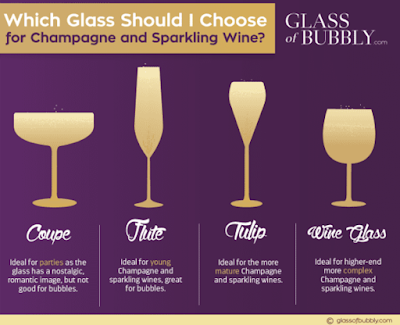What is Champagne is the big question? I knew it was in the wine family, and I knew it had bubbles, but that was the extent of my knowledge. I came across an online Zoom class all about champagne, and I decided to take it.
Here is a simplified definition I found in the Urban Dictionary.“Sparkling wine (achieved via means of a second fermintation) is produced from grapes grown in a legally defined area of France.”
Here are a few wine tidbits that were shared in the Zoom class.
*The cork from a bottle of champagne travels at approx 25 MPH when opened. (I found on another site it could be up to 55 MPH) Yikes!
*PSI is 70-90 pounds per square inch.
*On average, 24 people die every year from a champagne cork.
*The grapes that typically make champagne are Chardonnay, Pinot Noir, and Meunier.
*The bubbles you see when you put them in your glass are called “action.” The more narrow a glass, such as a flute, the more action you see.
*Champagne can be served in a Coupe, Flute, Tulip or regular Wine Glass
The thing that makes champagne unique and bubbly is that it is fermented twice. The first fermentation is like many of your typical wines. The second fermentation is completed in the bottle. More yeast and sugar are added to the bottle, and then the wine is corked and allowed to ferment again, which can take over a year.
Before the bottle of Champagne is ready for market, the excess yeast must be removed and this can take weeks by using a process called riddling.
“This process causes the sediment to collect in the neck of the bottle in preparation for disgorgement: the ejecting of the sediment under pressure that then leaves the wine perfectly clear.”
Comite Champagne
Which Champagne should I buy?
There are different levels of sweetness found in Champagne. I know in the past, when I have been shopping for champagne, I had no idea what the terminology on the bottle meant. Here is a photo from Wine Folly that explains the sweetness levels a bit more. I would lean toward the center of the chart.
How to open a bottle of Champagne
After reading about the PSI and the speed of the cork when dislodged and that people actually die when hit by the cork, I think we have to be a bit cautious when opening our bottle of Champagne. I was shown many years ago that one way to open the bottle is to use a dishtowel. I have used this technique on many occasions, and it has worked well. The thing I have been doing wrong is that I twisted the cork when I should have been turning the bottle. This video shows you how to open your bottle of Champagne.
One of the best tasting Champagnes I have ever had was at a Tea in Cary NC. My daughter Stephanie went to the Umstead for her birthday tea. We were offered a glass of Champagne. It was expensive, $26 a glass but it was lovely.
I am thinking about getting this one for Thanksgiving. Let’s look up the going price…
Looking online the average price ranges from $79-$100.
Experience has shown that the ideal temperature to serve Champagne is 8-10°C (47-50°F). Any colder and the Champagne will numb the taste buds. Under no circumstances chill a bottle of Champagne in the freezer; and never serve it in pre-chilled glasses (or you will lose some of the sparkle).
After opening your bottle keep it in an ice bath of half water half-ice at the tableside. When dinner is over, you can store your bottle in the fridge. Without a stopper the champagne will last about 24 hours with a champagne stopper it will last about 72 hours.
I ordered this stopper from Amazon. I also ordered a champagne bucket.
(You can click on either photo below to go to Amazon. I am an affiliate with Amazon, and if you buy anything on the site, I will make a percentage of the sale with no added cost to you. Thanks!).
I can’t wait to give them a try.
I hope this helps you make the right champagne choices for the upcoming holidays.
Cheers!
KathieyV:-)






